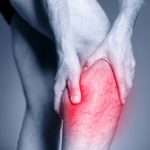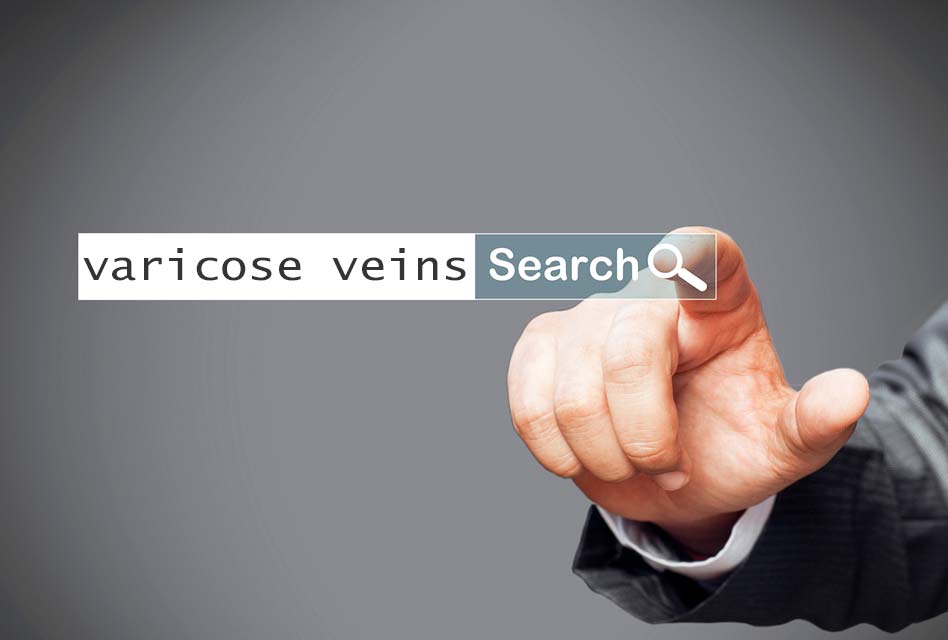Varicose Veins and Chronic Venous Insufficiency Explained in Simple Terms
Varicose Veins: Daily Double
In the Game of Jeopardy on TV, you have to answer the clue in terms of a question.
Here’s the answer to today’s daily double.
What is chronic venous insufficiency?

Tortuous, ropey, and bulging veins on the surface of the skin of the leg are a manifestation of an underling venous problem called chronic venous insufficiency.
It is not benign, is not just a cosmetic problem, and it is not uncommon.
The most common cause of chronic venous insufficiency (CVI) is genetics.
Obesity and pregnancy also contribute as important risk factors.
Occupations that involve long periods standing or sitting can exacerbate the condition.
There are many myths associated with the condition.
Walking on concrete, crossing your legs, and exercising do not cause CVI.
Learn about more varicose vein myths in this great bog post.
It is often overlooked or even ignored by primary care physicians when people complain of tired, achy, or swollen legs.

Elevation of the legs or walking often improve the symptoms.
Even though there are many reasons for leg pain, it is important to note that it is not a normal part of aging and it needs to be investigated by a vein specialist.
Essentially, chronic venous insufficiency (CVI) is hypertension or high blood pressure of the veins.
This shouldn’t be confused with high blood pressure of the arteries.
Hypertension or high blood pressure in the arteries is entirely different.
When people speak of high blood pressure, they are talking about increased pressure in the arteries.
When doctors take your blood pressure, they are measuring the pressure in your arteries.
High arterial blood pressure can lead to stroke, heart attack, kidney and eye disease.
High venous blood pressure can be detected with a venous ultrasound of the leg veins.
Venous insufficiency or venous hypertension is caused by the valves in the leg veins not closing properly.
This leads to the blood backing up and pooling in your legs.
Pooling of the blood in the legs is also called venous stasis.
In the veins, blood should only travel in one direction and that is toward your heart.
When your valves don’t close properly, gravity can pull the blood back towards your feet.
When that happens, the pressure inside of the veins increases.
That is venous hypertension which leads to chronic venous insufficiency (CVI).
Venous Ulcers from Chronic Venous Insufficiency (CVI)
The Stages of Varicose Veins
There are various stages of chronic venous insufficiency from mild to severe.
When venous insufficiency is ignored it can lead to venous ulcers which occurs in about one per cent of people.
It is estimated that between 500,000 to one million Americans suffer from venous ulcers according to Mayo Clinic data.
About two and a half million people have CVI in the United States.
More than 30 million people in the U.S. are affected by this disease to some extent.
Only 1.9 million seek treatment annually.
Therefore, the vast majority of people with CVI are undiagnosed and untreated.
A venous ulcer is a long-lasting (chronic) sore that often takes more than four to six weeks to heal.
They usually develop on the inside of the leg, just above the ankle.
The symptoms of a venous leg ulcer often include pain, itching and swelling in the affected leg.
There may also be discolored or hardened skin around the ulcer.
The sore may produce a foul-smelling discharge.
Superficial and Deep Veins of the Leg
The veins of the lower extremity can be divided into the superficial and deep venous system.
The superficial venous system is located above the muscles.
The deep veins are near the bones.
Varicose veins are a disease of the superficial veins.
Here is a great chart of their risks, signs, symptoms, and treatment.
Venous ulcers involve both the superficial and the deep veins of the leg in a majority of cases.
The superficial veins can be treated with minimally invasive treatments most of the time.
The deep vein problems can be divided into two groups, obstruction (blockage) or reflux (blood backing up because of defective valves).
Reflux in the deep veins is usually caused by a previous blood clot which damages the valves in these veins.
Obstruction of the deep veins is often located in the large pelvic veins called the iliac veins.
Obstruction in these vein is usually treated with stents which are inserted inside these pelvic veins to relieve the blockage.
Venous Ulcers
Chronic Venous Stasis Leg Ulcer from Chronic Venous Insufficiency
Venous ulcers are sores of the skin that usually occur on the inside of the ankle.
They are usually painful.
Often there is brown discoloration of the surrounding skin.
Venous ulcers are difficult to treat.
They are often a chronic and recurring problem.
For this reason, venous ulcers significantly affect quality of life and are a huge socioeconomic burden leading to disability and early retirement.
It’s estimated that it leads to 2% of the total healthcare costs in this country or 3 billion dollars per year.
If there is evidence of superficial venous insufficiency on venous Doppler ultrasound examination, that should be treated first.
From an economic standpoint alone, treatment of the abnormal superficial veins is extremely cost effective.
What Are the Manifestations of Chronic Venous Insufficiency
In its mildest forms, chronic venous insufficiency can be seen in the form of spider veins.
Larger veins with venous hypertension are the varicose veins.
Varicose veins if left untreated will eventually enlarge.
Neglected varicose veins can sometimes lead to blood clots within them called thrombophlebitis or phlebitis for short.
Swelling of the leg and darkening and toughening if the skin are later manifestations of chronic venous insufficiency.
Treatment of Chronic Venous Insufficiency
Varicose Vein Therapies
It is a common misconception that compression support stockings are a cornerstone of the treatment of this condition.
That is completely false and is another huge myth of varicose vein treatment.
Natural treatments, home remedies, and dietary changes have minimal effect on this condition.
These alternatives should only be tried if minimally invasive treatment methods are contraindicated.
In addition, exercise cannot reverse this condition.
No matter how much you exercise, it will not repair the valves within the affected veins which are usually the cause of the problem.
The treatment for superficial venous insufficiency is minimally invasive treatment of the involved veins without wasteful attempts at conservative measures especially compression support stockings.
This is contrary to most insurance requirements of three months of conservative medical management before coverage is approved.
If you have symptomatic varicose veins, you should be treated with minimally invasive treatments as the first choice, not support stockings.
This recommendation has been corroborated by venous experts in the United States and in the United Kingdom.
In superficial venous insufficiency, the saphenous veins are involved most of the time.
Stripping or removal of this vein was commonly performed before minimally invasive treatments became favored.
Phlebectomy (removal of the visible varicose veins through tiny incisions) or sclerotherapy (injections) are also usually required to complete the treatment.
These procedures allow for a quick, comfortable recovery and return to normal everyday activities and at the same time also improve the appearance of varicose veins.
The Bottom Line
The credentials and qualifications of the vein specialist are often overlooked when selecting a doctor.
Choosing a center by the convenience of the location of the vein clinic is a common mistake.
There’s really no good reason to put it off any longer.
Insurance often covers the treatment of both chronic venous insufficiency and also varicose veins when they are deemed to be medically necessary.
Check out our qualifications and then call us at 724-987-3220 to make an appointment today!

